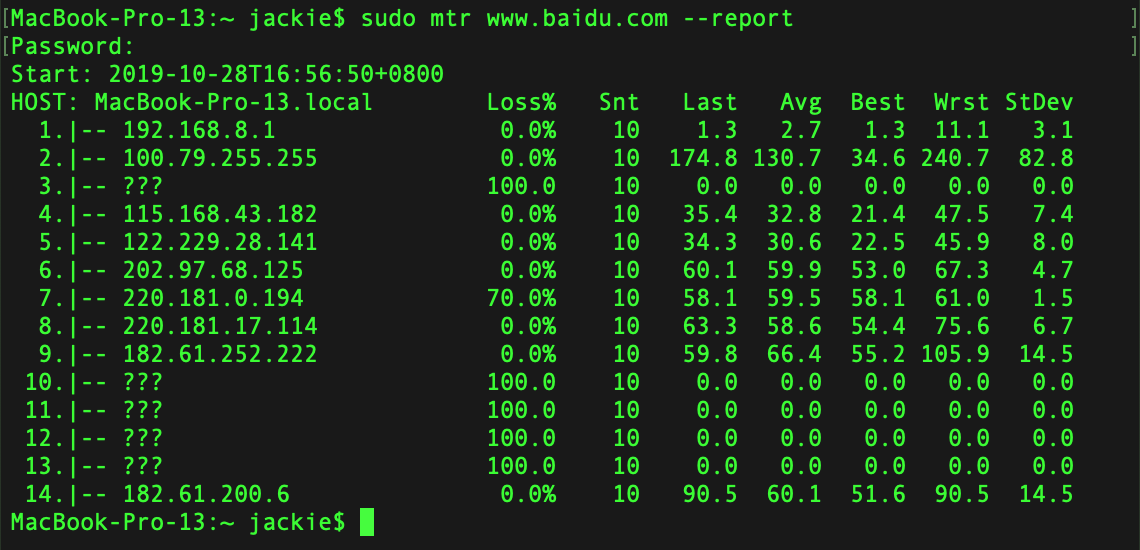MTR 是一款强大的网络诊断工具,它集成了 traceroute 和 ping 的功能,并且会收集更多的信息,比如连接状态、可用性等等,在排查网络问题中,非常有用。
MTR的安装
在 Linux 下可以直接使用 yum 工具(以 CentOS 为例)进行安装:
yum install mtr
在 Windows 下,建议安装 besttrace ,这款工具带了 MTR 的功能。
在 macOS 下,建议使用 brew 进行安装。
1、安装 brew
/usr/bin/ruby -e "$(curl -fsSL https://raw.githubusercontent.com/Homebrew/install/master/install)"
2、安装 MTR
brew install mtr
3、把程序文件复制到 /usr/local/bin 目录下
cd /usr/local/Cellar/mtr/0.92/sbin cp mtr /usr/local/bin/ cp mtr-packet /usr/local/bin/
4、运行 MTR 需要管理员权限,所以在运行的时候会提示输入密码
sudo mtr www.baidu.com
理解 MTR 报告

第一列:HOST,显示IP地址或者主机名。
第二列:Loss%,这个结点的丢包率。
第三列:Snt,发送包的数量。
第四列:Last,最近一次的延时,单位是毫秒ms。
第五列:Avg,平均延时,单位是毫秒ms。
第六列:Best,最低延时,单位是毫秒ms。
第七列:Wrst,最高延时,单位是毫秒ms。
第八列:StDev,标准偏差。
MTR 报告,我们一般看两样东西:丢包率和延迟。从上图中可以看到,有很多跳显示为 ??? (超时),并且丢包率为100%。这可能是家用路由器或者运营商的路由器没有正确配置导致的,但是数据还是正常传递的,看最后跳,丢包率为 0%,说明数据包全部到达目标主机。
导致丢包率主要有三个原因:
1、运营商限制 ICMP 速率。一些运营商会设置优先级,ICMP 包的优先级比较低,可能会被小部分丢弃。
2、ICMP 包在返回过程中出现丢包。数据包正常到达目的地,由于走不同的返程路由,在返回过程中出现丢包。因此,在遇到问题时,最好在两个方向收集 MTR 报告。
3、其他的网络故障。
MTR 参数详解
用法:mtr [参数] hostname
-F, --filename FILE read hostname(s) from a file
-4 use IPv4 only
-6 use IPv6 only
-u, --udp use UDP instead of ICMP echo
-T, --tcp use TCP instead of ICMP echo
-a, --address ADDRESS bind the outgoing socket to ADDRESS
-f, --first-ttl NUMBER set what TTL to start
-m, --max-ttl NUMBER maximum number of hops
-U, --max-unknown NUMBER maximum unknown host
-P, --port PORT target port number for TCP, SCTP, or UDP
-L, --localport LOCALPORT source port number for UDP
-s, --psize PACKETSIZE set the packet size used for probing
-B, --bitpattern NUMBER set bit pattern to use in payload
-i, --interval SECONDS ICMP echo request interval
-G, --gracetime SECONDS number of seconds to wait for responses
-Q, --tos NUMBER type of service field in IP header
-e, --mpls display information from ICMP extensions
-Z, --timeout SECONDS seconds to keep probe sockets open
-r, --report output using report mode
-w, --report-wide output wide report
-c, --report-cycles COUNT set the number of pings sent
-j, --json output json
-x, --xml output xml
-C, --csv output comma separated values
-l, --raw output raw format
-p, --split split output
-t, --curses use curses terminal interface
--displaymode MODE select initial display mode
-n, --no-dns do not resove host names
-b, --show-ips show IP numbers and host names
-o, --order FIELDS select output fields
-y, --ipinfo NUMBER select IP information in output
-z, --aslookup display AS number
-h, --help display this help and exit
-v, --version output version information and exit
扩展阅读:
官网:https://www.bitwizard.nl/mtr/
Linode 帮助文档发布的一篇很详细的教程,国内不少教程直接翻译自这篇:https://www.linode.com/docs/networking/diagnostics/diagnosing-network-issues-with-mtr/